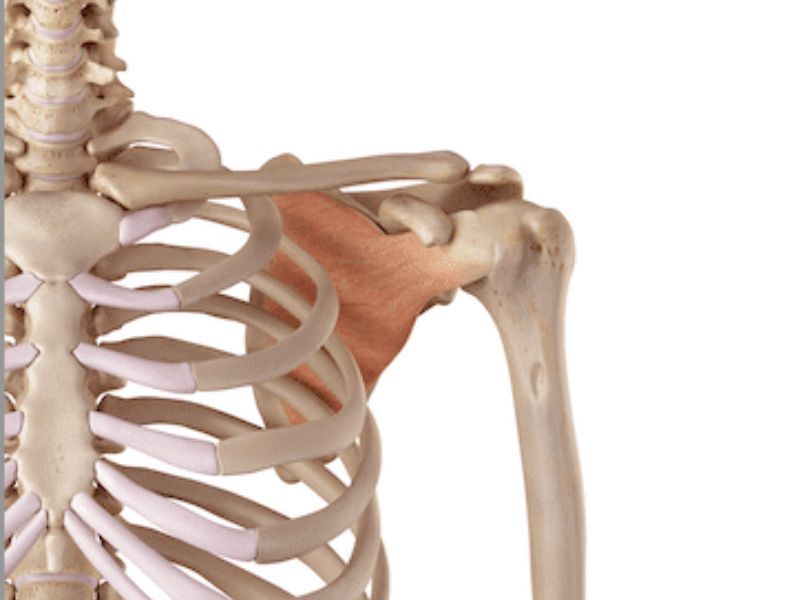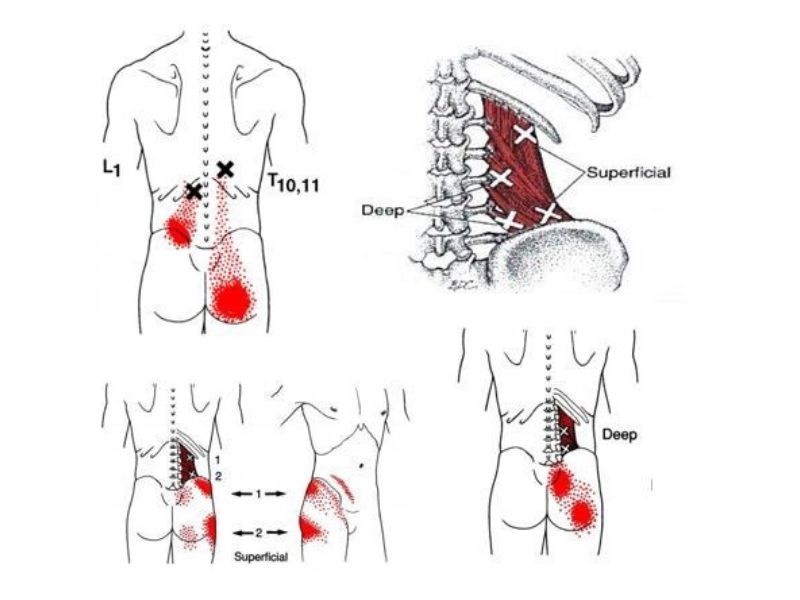Subscapularis Trigger Point | How To Find And Self-Release

Table of Contents
Shoulder pain can be a frustrating obstacle in our daily lives, impacting everything from lifting groceries to swinging a tennis racket. If you’ve been struggling with this kind of discomfort, you may have heard about the elusive subscapularis trigger point—a common yet often overlooked source of shoulder woes.
This tiny spot on one of your rotator cuff muscles might just hold the key to relief.
Interestingly, research has shown that there’s a strong association between subscapularis trigger points and conditions like frozen shoulder or adhesive capsulitis. Our blog will guide you through understanding this muscle’s role, how to detect problematic trigger points yourself, and effective strategies for soothing them away.
Ready to wave goodbye to that stubborn shoulder pain? Let’s dive in and discover how proper care can bring back comfort and mobility!
Key Takeaways
- The subscapularis muscle is a key component of the rotator cuff that helps in shoulder stability and can develop painful trigger points due to overuse or injury.
- Identifying subscapularis trigger points involves feeling for tender spots beneath the shoulder blade, which can cause pain that radiates down the arm or to the front of the shoulder.
- Self – release techniques, such as applying pressure with fingers or a massage tool and using targeted stretches and exercises, can significantly alleviate pain from these trigger points.
- Neuromuscular massage therapy is an effective treatment that targets deep muscle layers to relieve discomfort and improve movement in shoulders afflicted by subscapularis trigger points.
- Regular practice of specific stretching and strengthening routines for the subscapularis muscle supports better shoulder function and can prevent future pain issues.
Understanding Subscapularis and its Role in Shoulder Function

Delving deeper into the anatomy of the shoulder, we encounter the subscapularis muscle—a key player in maintaining shoulder stability. This muscle, part of the rotator cuff group, lies beneath the shoulder blade and is crucial for internal rotation of the arm.
It’s an integral component that allows us to perform simple actions like reaching behind our back or throwing a ball.
The subscapularis anchors on the lesser tubercle of the humerus and plays a significant role in how we move our shoulders. It helps keep the head of the humerus securely within its socket and ensures smooth movement against other bones around it, such as when lifting your arm overhead.
As one might expect from such a hardworking muscle, trigger points can develop due to overuse or injury—these tender spots are notorious for causing pain and limiting motion in various directions.
Addressing these problematic areas through targeted therapy can improve mobility and alleviate discomfort significantly.
Identifying Subscapularis Trigger Points

Identifying subscapularis trigger points is a crucial step towards addressing shoulder pain and restricted movement. These sensitive nodules within the muscle fibers can cause discomfort extending beyond the immediate area, often presenting symptoms that mimic other shoulder conditions, thus making accurate diagnosis key to effective treatment.
Symptoms and referral patterns
Symptoms of subscapularis trigger points may include a dull ache or sharp pain in the shoulder, often misidentified as a problem with other parts of the rotator cuff. This discomfort can extend down the arm or to the front of the shoulder and is frequently accompanied by restricted range of motion, making simple activities like reaching overhead challenging.
Individuals might experience referred pain that radiates toward the back of the shoulder or down to their wrist, which can sometimes be mistaken for neck pain.
Referral patterns for subscapularis trigger points are complex due to their connection with common shoulder conditions like frozen shoulder and myofascial pain syndromes. The muscle’s role in stabilizing and moving the shoulder means active trigger points can seriously disrupt regular activities, emphasizing why proper treatment is essential.
Trigger point therapy aims to address these specific areas within the subscapularis muscle to alleviate pain and restore movement.
Association with shoulder disorders
Subscapularis trigger points can have a significant impact on the health of your shoulder joint. These troublesome spots within the subscapularis muscle contribute to a range of shoulder disorders, often creating pain that may radiate down the arm or to the front of the shoulder.
Stabilization and movement suffer when these trigger points are active, as they directly affect one of the rotator cuff muscles responsible for medial rotation and proper function.
Not only do such trigger points bring discomfort, but they can also be linked with more serious conditions like frozen shoulder. Cross-sectional studies highlight a notable degree of association between myofascial pain in this area and conditions characterized by reduced mobility and persistent muscle pain.
Given their location near vital attachment points for tendons and ligaments around the armpit area, managing these trigger points is crucial for maintaining overall shoulder health and preventing further complications that restrict everyday activities.
Remedies for Subscapularis Trigger Points
To address the discomfort caused by subscapularis trigger points, both self-care measures and professional therapies can be highly effective. Exploring self-release techniques along with specific exercises to stretch and strengthen the muscle can lead to significant relief and improved shoulder mobility.
Self-release techniques
Self-release techniques can be a powerful way to manage and reduce pain from subscapularis trigger points. These methods allow individuals to take control of their discomfort and improve shoulder function.

- Locate the subscapularis muscle by reaching under the shoulder blade at the back, where it attaches to the humerus bone.
- Gently press this area with your fingers or a massage tool until you find tender spots indicative of trigger points.
- Once a trigger point is located, apply steady, moderate pressure for about 30 seconds to 1 minute, or until a noticeable reduction in pain occurs.
- For areas that are difficult to reach, use a tennis ball or similar object against a wall for leverage and targeted pressure.
- Include slow and controlled movements of the arm while maintaining pressure on the trigger point to help mobilize and release tension.
- Combine these techniques with deep breathing, focusing on exhaling as you apply pressure to help relax the muscle further.
- Repeat these steps several times throughout the day, especially before and after activities that typically aggravate your shoulder pain.
Stretching and exercise recommendations
Stretching and regularly exercising the subscapularis muscle can significantly improve shoulder movement and alleviate pain. These activities help maintain muscle flexibility, which is crucial for shoulder stability and function.
- Begin with gentle daily stretches to warm up the subscapularis muscle before progressing to exercises. It’s important not to rush and risk additional strain.
- Practice cross – body arm stretches by pulling your affected arm across the front of your body with your other hand, feeling a stretch in the back of the shoulder.
- Incorporate doorway stretches: Stand in a doorway with arms on the frame at a 90-degree angle, then step forward to stretch the front of the shoulders and chest.
- Perform external rotation stretches by holding a towel or band behind your back with both hands and gently lifting upwards with your unaffected arm, stretching the affected side.
- Gradually introduce strengthening exercises like internal and external rotation movements using resistance bands to build muscular support around the shoulder.
- Implement scapular stabilization exercises such as wall push-ups or scapular retraction movements to strengthen surrounding muscles like teres major and latissimus dorsi that support the subscapularis.
- Use foam rollers or tennis balls as self – massage tools to apply pressure on tight areas around the scapula, aiding in releasing tension in trigger points.
Role of Neuromuscular Massage Therapy in Treating Subscapularis Trigger Points
Neuromuscular massage therapy plays a critical role in alleviating the discomfort caused by subscapularis trigger points. This specialized form of massage targets the specific areas of muscle where pain trigger points have formed.
Practitioners use a combination of deep pressure and friction to release these knotted areas, helping to reduce pain and improve mobility in the shoulder. Properly applied neuromuscular techniques can lead to significant relief for those suffering from shoulder pain complaints, which are often linked to myofascial trigger points within the subscapularis.
The effectiveness of this therapy lies in its ability to not only address surface tension but also penetrate deeper layers of muscle tissue where hidden trigger points may reside. By relaxing and lengthening the affected muscle fibers, neuromuscular massage aids in restoring normal function and movement to the shoulder joint.
Patients who receive this type of treatment may find it easier to move their shoulders without experiencing sharp pains that can radiate down the arm or across other parts of the body.
As we delve into remedies for these painful triggers, remember that consistency is key for lasting results.
Conclusion
Taking control of subscapularis muscle pain is key to enhancing shoulder function and comfort. Effective treatments, such as targeted massage therapy and carefully guided self-release techniques, offer relief from the discomfort caused by trigger points.
Incorporating stretching and exercises into your routine can further help in stabilizing the shoulder and preventing future issues. If you’re dealing with persistent pain that radiates down your arm or across your shoulder, exploring trigger point therapy might provide the solution you need.
Empower yourself by understanding how to identify and address subscapularis trigger points for better mobility and well-being.
FAQs
1. What is a subscapularis trigger point?
A subscapularis trigger point is a sensitive area in the muscle that can cause pain and limit movement in the shoulder.
2. Where do I find the subscapularis muscle to check for trigger points?
You’ll find the subscapularis muscle on the front of your body, below your shoulder blade, contributing to movements of the shoulder.
3. Can trigger points in the subscapularis lead to frozen shoulder?
Yes, some studies suggest there’s an association between frozen shoulder and subscapularis trigger points due to adhesions restricting motion.
4. How can releasing these trigger points help my shoulder?
Releasing these trigger points may reduce pain and aid in restoring full range of motion, allowing you to move your shoulders more freely.
5. Is it common for people with wrist pain also have issues with their subscapularis?
It is possible as discomfort from triger points often radiates; if you have wrist pain or back of neck soreness, it could be related to problems with this part of your shoulder.
Sam Visnic
I’ve spent my life studying the fundamental aspects of human health with a focus on movement and clinical massage therapy. In a world of specialists, surgical procedures, drugs and quick fix remedies, I’m committed to finding and developing strategies that help people stuck at the “gap”. Over the last 20 years I’ve studied dozens of systems and methodologies for uncovering the root cause of aches and pains, along with postural and movement issues. Pain science, the art and science of hands-on soft tissue massage techniques, myofascial release, and coaching movement is essential in my practice. Integrating different methods but above all deciphering WHEN to use different techniques with different people and situations, along with integration of movements that people want to be able to do again is the key to long term success with my incredible track record with clients. Understanding the various elements that contribute to conditions and the power of communication and education makes my Release Muscle Therapy program separate from other hands-on therapy approaches.
Blogs You May Be Interested In
Categories
-
Deep Gluteal Pain Syndrome
-
Deltoids
-
Fallbrook
-
Foam Rolling
-
Glutes
-
Hamstrings
-
Hypnosis For Pain
-
Lats
-
Levator Scapulae
-
Lifestyle
-
Massage Therapy
-
Mobility
-
Movement and Exercise
-
Murrieta
-
Muscles
-
Nutrition
-
Obliques
-
Pain
-
Pectorals
-
Piriformis
-
Plantar Fasciitis
-
Product Review
-
Psoas
-
Quadratus Lumborum
-
Quadriceps
-
Rhomboids
-
Serratus Anterior
-
SI Joint
-
Sternocleidomastoid
-
Stretching
-
Subscapularis
-
Temecula
-
TMJ
-
Trapezius
-
Uncategorized
















